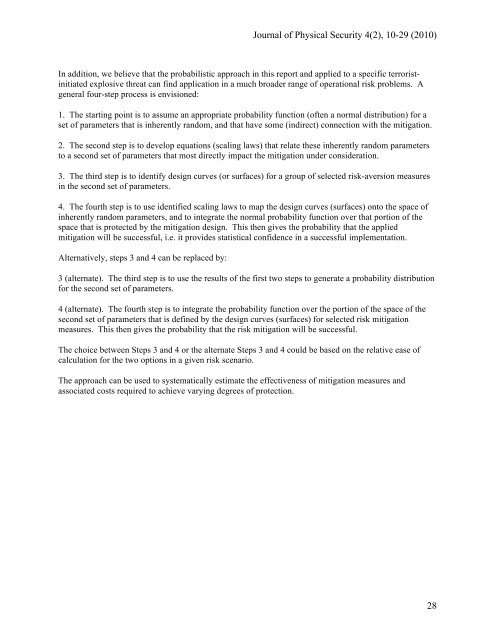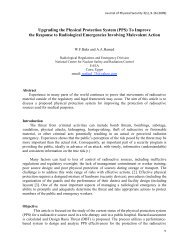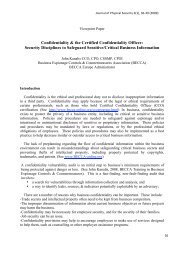<strong>Journal</strong> <strong>of</strong> <strong>Physical</strong> <strong>Security</strong> 4(2), 10-29 (2010)In addition, we believe that the probabilistic approach in this report and applied to a specific terroristinitiatedexplosive threat can find application in a much broader range <strong>of</strong> operational risk problems. Ageneral four-step process is envisioned:1. <strong>The</strong> starting point is to assume an appropriate probability function (<strong>of</strong>ten a normal distribution) for aset <strong>of</strong> parameters that is inherently random, and that have some (indirect) connection with the mitigation.2. <strong>The</strong> second step is to develop equations (scaling laws) that relate these inherently random parametersto a second set <strong>of</strong> parameters that most directly impact the mitigation under consideration.3. <strong>The</strong> third step is to identify design curves (or surfaces) for a group <strong>of</strong> selected risk-aversion measuresin the second set <strong>of</strong> parameters.4. <strong>The</strong> fourth step is to use identified scaling laws to map the design curves (surfaces) onto the space <strong>of</strong>inherently random parameters, and to integrate the normal probability function over that portion <strong>of</strong> thespace that is protected by the mitigation design. This then gives the probability that the appliedmitigation will be successful, i.e. it provides statistical confidence in a successful implementation.Alternatively, steps 3 and 4 can be replaced by:3 (alternate). <strong>The</strong> third step is to use the results <strong>of</strong> the first two steps to generate a probability distributionfor the second set <strong>of</strong> parameters.4 (alternate). <strong>The</strong> fourth step is to integrate the probability function over the portion <strong>of</strong> the space <strong>of</strong> thesecond set <strong>of</strong> parameters that is defined by the design curves (surfaces) for selected risk mitigationmeasures. This then gives the probability that the risk mitigation will be successful.<strong>The</strong> choice between Steps 3 and 4 or the alternate Steps 3 and 4 could be based on the relative ease <strong>of</strong>calculation for the two options in a given risk scenario.<strong>The</strong> approach can be used to systematically estimate the effectiveness <strong>of</strong> mitigation measures andassociated costs required to achieve varying degrees <strong>of</strong> protection.28
<strong>Journal</strong> <strong>of</strong> <strong>Physical</strong> <strong>Security</strong> 4(2), 10-29 (2010)ReferencesANFO, at http://en.wikipedia.org/wiki/ANFOBrode, H.L., Numerical solution <strong>of</strong> spherical blast waves, J App Phys 26, 766-775 (1955)Explosives – ANFO *Ammonium nitrate-fuel oil), athttp://www.globalsecurity.org/military/system/munition/explosives-anfo.htmHeld, M., Blast waves in free air, Propellants, Explosives, Pyrotechnics 8, 1-7 (1983)Jeremic, R., and Bajic, Z., An approach to determining the TNT equivalent <strong>of</strong> high explosives, Scientific-Technical Review 56, 58-62 (2006)Kinney, Gilbert F., Explosive Shocks in Air. N.Y.: <strong>The</strong> MacMillan Co. (1962)Mills, C.A., <strong>The</strong> design <strong>of</strong> concrete structure to resist explosions and weapon effects, Proceedings <strong>of</strong> the1 st Intl. Conf. On concrete for hazard protections, Edinburgh, UK, 61-73 (1987)Netherton, N.D., and Stewart, M.G., <strong>The</strong> effects <strong>of</strong> explosive blast load variability on safety hazard anddamage risks for monolithic window glazing, International <strong>Journal</strong> <strong>of</strong> Impact Engineering, 36 (2009)1346-1354Newmark, N.M., and Hansen, R.J., Design <strong>of</strong> blast resistant structures, Shock and Vibration Handbook 3,eds. Harris, C.M., and Crede, C.E.. N/Y.: McGraw-Hill (1961)Ngo, T., Mendis, P., Gupta, A., and Ramsay, T., Blast loading and blast effects on structures – anoverview, EJSE Special issue: Loading on structures, 76-91 (2007)Stewart, M.G., Netherton, M.D., Rosowsky, D.V., Terrorism risks and blast damage to builtinfrastructure, Natural Hazards Review 7, 114-122 (2006)TB 700-2, NAVSEAINST 8020.8 B, DOD Ammunition and Explosives Hazards ClassificationProcedures, Washington DC (1999)TM 5-1300, <strong>The</strong> Design <strong>of</strong> Structures to Resist the Effects <strong>of</strong> Accidental Explosions, Technical Manual,US Department <strong>of</strong> the Army, Navy, and Air Force, Washington DC, 199029
- Page 2 and 3: Table of ContentsJournal of Physica
- Page 4 and 5: The Journal of Physical Security 4(
- Page 6 and 7: The Journal of Physical Security 4(
- Page 8 and 9: The Journal of Physical Security 4(
- Page 10 and 11: The Journal of Physical Security 4(
- Page 12 and 13: Journal of Physical Security 4(2),
- Page 14 and 15: Journal of Physical Security 4(2),
- Page 16 and 17: Journal of Physical Security 4(2),
- Page 18 and 19: Journal of Physical Security 4(2),
- Page 20 and 21: Journal of Physical Security 4(2),
- Page 22 and 23: Journal of Physical Security 4(2),
- Page 24 and 25: Journal of Physical Security 4(2),
- Page 26 and 27: Journal of Physical Security 4(2),
- Page 28 and 29: Journal of Physical Security 4(2),
- Page 30 and 31: Journal of Physical Security 4(2),
- Page 33 and 34: Journal of Physical Security 4(2),
- Page 35 and 36: Journal of Physical Security 4(2),
- Page 37: Journal of Physical Security 4(2),
- Page 41 and 42: Journal of Physical Security 4(2),
- Page 43 and 44: Journal of Physical Security 4(2),
- Page 45 and 46: Journal of Physical Security 4(2),
- Page 47 and 48: Journal of Physical Security 4(2),
- Page 49 and 50: Journal of Physical Security 4(2),
- Page 51 and 52: Journal of Physical Security 4(2),
- Page 53 and 54: Journal of Physical Security 4(2),
- Page 55 and 56: Journal of Physical Security 4(2),
- Page 57: Journal of Physical Security 4(2),





